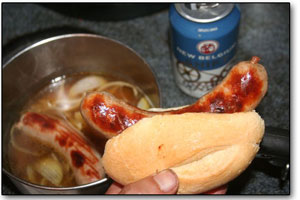
Midwestern soul food
Wisconsinites are generally a congenial lot. Those Cheeseheads love their Green Bay Packers, Friday Fish Fries, and beer and bratwurst. And they aren’t big on drama. Until Scott Walker came around, there wasn’t much to argue about, except, well, beer and bratwurst.
Wisconsin’s largest ancestry group is German, who brought their bratwurst with them. And while brats are beloved by all Sconnies, there is quiet discord over the ritual of bathing brats in beer. They disagree, for the most part politely, not only over when to do this, but why.
 The dominant sentiment among beer soakers is that brats should soak in hot beer before going on the grill. There is, however, a small but knowledgeable contingent of brat scholars that puts its brats in warm beer after cooking, not before.
The dominant sentiment among beer soakers is that brats should soak in hot beer before going on the grill. There is, however, a small but knowledgeable contingent of brat scholars that puts its brats in warm beer after cooking, not before.
The idea behind soaking bratwurst in hot beer prior to grilling is they cook all the way through ahead of time, so the grill master needn’t worry about serving an undercooked pork sausage. The pre-cooked brats spend a brief amount of time on the grill to get browned, and are served. By spending less time on the grill the brat is less likely to dry out, and some pre-soakers believe the brat soaks up a meaningful amount of beer to influence the flavor and juiciness. The beer also makes the sausage casings more pliable and less likely to split.
Once, when I told a bartender from Milwaukee I wanted to try the beer-bratwurst thing, he preached about the holy trinity of beer flavorings: garlic, onion and black pepper. And before he would agree to fill my growler, he made me promise to pre-cook in Old Milwaukee, not the fancy microbrew IPA he was pouring.
But in Sheboygan, Wis., widely considered the capitol of bratwurst, many locals politely shake their heads at this pre-soaking business. Chuck Miesfeld is a fourth-generation sausage maker and owner of Miesfeld Meat Market in Sheboygan. He agreed to speak with me about when to soak a brat in beer and why, in hopes that it might help “straighten those people out.”
“The whole deal with soaking them in beer,” Miesfeld told me, “is about keeping the brats warm until you put them on your hard roll. If you’re cooking brats on a charcoal grill, which is the only way you should be doing it, and there’s nobody standing there with a hard roll, there has to be a way to keep them warm.”
The hard roll of which Miesfeld speaks, the only Sheboygan-approved brat holder, is the antithesis of the soft hot dog buns upon which brats are too often served. Even at Miller Park in Milwaukee, the only baseball stadium in America that serves more brats than dogs, brats are served on “squishy buns,” as Miesfeld calls them. If you don’t live within striking distance of a Sheboygan bakery, your best bet would be a German or Austrian bakery that makes a hard-crusted white dinner roll. In Sheboygan it’s customary to pack two brats into a single roll.
As for the idea that the pre-soaking results in a juicier brat, Miesfeld isn’t impressed. If a brat dries out on the grill, he said, it was either overcooked or a sub-par product.
But while the primary purpose of a post-grill soak is to keep the brats in optimal shape for serving, Miesfeld concedes that the submersion adds more than heat.
“You do grab some flavors from the beer, but that’s not the real point. If you were doing it for flavors you’d want to leave the brat in there a long time, but you don’t want to leave the brats in too long, because they get mushy. It’s just a half-hour thing.”
Miesfeld’s post-cooking brat bath includes butter and onions in beer. Miesfeld also urged me not to use good beer. It should be kept at around 180 degrees, which is not quite simmering. And there is no place for black pepper. “If you have to add black pepper, you’ve got a shitty brat.”
While he isn’t a pre-soaker, Miesfeld does drop the brats into cold water for five minutes before grilling, which softens the casings, making them less likely to split.
The key to proper grilling is to not have the fire too hot. Control any flare-ups with water, and turn them often. Skilled brat chefs can determine with a squeeze of their fingers when a brat is cooked, but when a meat thermometer, poked into the end, reaches 180 degrees, it’s done.
I followed Miesfeld’s instructions, mixing a can of cheap lager with a tablespoon of butter and half an onion. And against everyone’s advice, I couldn’t help making another beer bath with a high-quality IPA. I compared brats that were pre-soaked in each of beer bath with those immersed after grilling. I also made a brat that was simply grilled, without any exposure to beer.
The brats placed in beer after grilling were noticeably juicier. They had more of a beery flavor, and I’m sure the butter didn’t hurt. I preferred them. The pre-soaked brats were closer in flavor to the non-soaked brat, and juicier, but less juicy than brats soaked after cooking.
As for any difference between the fancy IPA and the cheap lager, I couldn’t detect any. At least, on this, we can all agree.
